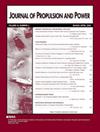固体燃料冲压发动机的回归率测量使用x射线摄影和超声波换能器
IF 2.4
4区 工程技术
Q2 ENGINEERING, AEROSPACE
引用次数: 1
摘要
采用x射线照相和超声换能器测量方法对固体燃料冲压发动机燃烧室内的瞬时燃料回归率进行了表征。实验采用圆柱形中心穿孔端羟基聚丁二烯燃料颗粒,在三种质量流量下([公式:见正文]),在相同的进口总温度和燃烧室压力下进行。超声换能器测量显示腹板厚度的变化范围为7.50至9.85 mm,回归率测量范围为1.35至[公式:见文]。用超声换能器测量了流动再附着和侵蚀燃烧引起的腹板厚度局部最大变化。根据x线摄影图像,推导出端口半径在8 ~ 9mm量级的变化和近似的回归速率[公式:见文]。在燃烧室入口附近拍摄的x射线图像中,流动再附着区域的结构很明显,而在燃烧室中部拍摄的图像显示出更均匀的燃料回归曲线。超声测量腹板厚度变化的幅度始终大于x射线测量。x射线成像允许以最大的轴向空间分辨率更准确地测量燃料回归,而超声波换能器测量产生最大的径向空间分辨率。与x射线照相相比,用基于重量的技术计算的腹膜厚度变化产生了较小的腹膜厚度变化测量值。在所研究的运行状态下,回归率与质量通量基本不变。本文章由计算机程序翻译,如有差异,请以英文原文为准。
Solid-Fuel Ramjet Regression Rate Measurements Using X-Ray Radiography and Ultrasonic Transducers
The instantaneous fuel regression rate within a solid-fuel ramjet combustor was characterized using X-ray radiography and ultrasonic transducer measurements. Experiments were performed with cylindrical center-perforated hydroxyl-terminated polybutadiene fuel grains at three mass fluxes ([Formula: see text]) with consistent inlet total temperatures and chamber pressures. Ultrasonic transducer measurements demonstrated changes of web thickness ranging from 7.50 to 9.85 mm and regression rate measurements ranging from 1.35 to [Formula: see text]. The local maxima of change in the web thickness due to flow reattachment and erosive burning were consistently measured with the ultrasonic transducers. Changes in the port radius on the order of 8–9 mm and regression rates of approximately [Formula: see text] were deduced from the X-ray radiography images. The structure of the flow reattachment region was evident in measurements from the X-ray radiography images captured near the combustor entrance, whereas images captured at the midlength of the combustor exhibited more uniform fuel regression profiles. Ultrasonic measurements of change in the web thickness were consistently greater in magnitude relative to X-ray radiography measurements. X-ray radiography imaging allowed for the more accurate measurement of fuel regression with the greatest axial spatial resolution, whereas ultrasonic transducer measurements yielded the greatest radial spatial resolution. The change in web thickness calculated with weight-based techniques yielded smaller-magnitude measurements of change in the web thickness relative to X-ray radiography. The regression rate was largely invariant with the mass flux within the investigated operating regime.
求助全文
通过发布文献求助,成功后即可免费获取论文全文。
去求助
来源期刊

Journal of Propulsion and Power
工程技术-工程:宇航
CiteScore
4.20
自引率
21.10%
发文量
97
审稿时长
6.5 months
期刊介绍:
This Journal is devoted to the advancement of the science and technology of aerospace propulsion and power through the dissemination of original archival papers contributing to advancements in airbreathing, electric, and advanced propulsion; solid and liquid rockets; fuels and propellants; power generation and conversion for aerospace vehicles; and the application of aerospace science and technology to terrestrial energy devices and systems. It is intended to provide readers of the Journal, with primary interests in propulsion and power, access to papers spanning the range from research through development to applications. Papers in these disciplines and the sciences of combustion, fluid mechanics, and solid mechanics as directly related to propulsion and power are solicited.
 求助内容:
求助内容: 应助结果提醒方式:
应助结果提醒方式:


